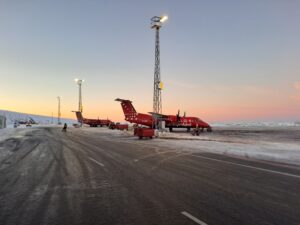In 1953, Greenland was made an integral part of the Kingdom of Denmark. In 1979 it got Home Rule and on June 21st 2009, Self Rule was introduced, whereby it was recognized “that the people of Greenland are a people pursuant to international law with the right of self-determination” (Self-Government Act, 2009: 1). Greenland has its own legislative assembly (Inatsisartut) and government (Naalakkersuisut) and has taken over many areas of responsibilities from Denmark; e.g. the right to any possible mineral riches in the Greenland subsoil and subsea. Within the Self-Government Act, Greenland can, however, not adopt its own Constitution; establish its own Supreme Court; or legislate on monetary, citizenship, defence, security or foreign issues. There is, however, room for negotiations in foreign policy matters, best exemplified by the bilateral relations with the European Union: after joining the European Community—as it was called back then—in 1973, Greenland withdrew in 1985 following an amendment a few years earlier. Instead, Greenland was accepted as one of the Overseas Countries and Territories (OCT) with special association with the EU. Besides this important exception, Greenland is usually part of the Danish delegation in important, international forums such as NATO, WTO and UN. In matters concerning Greenland in particular, e.g. indigenous peoples’ rights, a representative from Greenland will often present the Kingdom of Denmark’s collective statement. Connections to other indigenous peoples in the Arctic are also enhanced through the Inuit Circumpolar Council (ICC) founded in 1977.
The Kingdom of Denmark Strategy for the Arctic 2011-2020 emphasises four areas of priority: 1) security, safety and sovereignty; 2) sustainable development of new economic opportunities; 3) climate changes; and 4) international cooperation. Two objectives can be identified in the strategy: first, to react to the environmental and geopolitical changes occurring in the Arctic, hence responding to the growing global interest in the region. Secondly, the Kingdom of Denmark should redefine its position in the region by enhancing its status as a central Arctic player. This should first and foremost benefit the Arctic inhabitants (pp. 9-11).
International cooperation is a key word in the strategy, reflecting that it has always been at the core of the Kingdom of Denmark’s approach to the Arctic. As often emphasized in Danish discussions about Arctic politics, the Ilulissat Declaration of May 2008 is an example par excellence of how to act pro-actively to ensure continuously peaceful development in the Arctic. Denmark’s then Minister of Foreign Affairs, Per Stig Møller, was the initiator of this declaration, which makes it clear that the Arctic Five— the countries bordering the Arctic Ocean—remain committed to an “orderly settlement of any possible overlapping claims” (p.1).
The UN’s Commission on the Limits of the Continental Shelf (CLCS) provides recommendations on what an orderly settlement should be. These recommendations are based on a thorough review of the geological data submitted by the states. The Kingdom of Denmark claims a territory of 895,000 km2 in the Arctic Ocean of which significant parts overlap with Russia’s claim—and probably also Canada’s. As Denmark is currently number 76 in line, we will have to wait about a decade before the CLCS will come to a conclusion. When it does it is likely that several claims to the same area will be deemed valid due to the rules applying. If this happens, international cooperation will be critical. In this regard, the 2010 Barents Sea Agreement between Norway and Russia stands as a great example of how to solve any such overlapping interests.
The five Arctic littoral states are often highlighted as a dynamic group that makes things happen. This has most recently been underlined by a common moratorium on fishing in the high seas portion of the central Arctic Ocean and a polar bear action plan. Enhanced cooperation in the Arctic Council is, however, also encouraged and given high priority by the Kingdom of Denmark. The last time the Kingdom of Denmark held the Arctic Council chairmanship was from 2009-2011 and will next hold it from 2023-2025. Greenland is represented by both the ICC and the Danish delegation, while the West Nordic Council—consisting of Greenland, Iceland and the Faroe Islands—obtained observer status in 2017. The fact that Greenland is not represented directly in the Arctic Council, but has to be part of the Danish delegation, has from time to time resulted in discontent among Greenlandic politicians. The most dramatic example of this was when former Premier of Greenland, Aleqa Hammond, decided to boycott the Arctic Council ministerial gathering in Kiruna, Sweden in May 2013. Similar actions have not since been taken, but discontent is still often articulated from all sides of the Inatsisartut, thus indicating that it is a central priority of Greenland’s politicians and will likely remain present in Danish politics for some time to come.
The Kingdom of Denmark is an Arctic state because of Greenland. Thus, it is natural that their Arctic strategy focuses more thoroughly on the risks and opportunities in that part of the Danish Realm—although it does figure less prominently than in the 2008 strategy. Denmark’s status as an Arctic state is central to the fact that it punches above its weight in international politics. To keep this favourable position in the future, it is important to maintain the realm while developing it, so Greenland, the Faroe Islands and Denmark are all satisfied with its structure. To achieve this, Denmark will probably have to relinquish some of its power so that the triangular relationship will become more equal than it is today. If not, the Greenlandic and Faroese autonomy movements are likely to grow which could, in turn, ultimately result in secession and the end of the Danish Realm.
The Kingdom of Denmark’s Arctic strategy is in no way controversial. It strongly emphasizes the importance of international cooperation while acknowledging the risk of conflict. Like all the other Arctic strategies it highlights the risks and opportunities emerging in step with increased temperatures caused by global climate change. It is repeatedly emphasized that any development has to be sustainable. What this means is not always clear. As a result, ‘sustainable’ risks becoming an empty buzzword. Details outlining concrete plans on how to achieve the goals of the strategy would be a welcome improvement. Words must be followed by action, so if the Kingdom of Denmark really intends to “strengthen the Kingdom’s status as global player in the Arctic” (p.11) it will need to give economic priority to its presence in the Arctic.
The Kingdom of Denmark’s Arctic strategy was supposed to be replaced with a new version by the end of 2020. However, it has been delayed due to 3 causes (at least): COVID-19, the Greenland general election in the spring of 2021 and because the new Greenland Self-Government wants to write its own Foreign Policy Strategy before engaging in the writing of a new Arctic strategy for the kingdom as a whole. In the winter of 2022, the Government of Denmark confirmed that the Arctic remains one of Denmark’s most important foreign- and security policy priorities.


